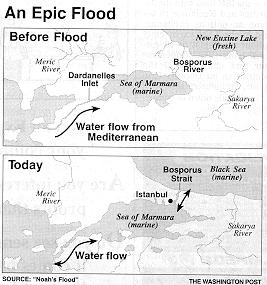The rise in the level of the Black Sea by hundreds of meters probably wiped out many settlements 7,500 years ago

One of the biggest holes in human knowledge is pre-historical knowledge, while in the later periods you can use certificates, in the earlier stage you have to rely on tools. The culture appeared seemingly out of nowhere in Egypt, Persia and Greece, but geological tests showed that the sea level was not uniform over the years. Considering that in ancient times people loved to live by the sea and sail in boats, it is clear that any flood could wipe out the entire cultural settlement of that time.
Marine archaeologist Robert Ballard reported today on the discovery of the settlement of Ennushi at a depth of tens of meters below the surface of the Black Sea. Tree horns and branches were discovered in a place that was flooded by sea water 7,500 years ago. The horns were used as tools for many applications. Many scientists today believe that this flood, which wiped out entire civilizations, is the source of the biblical story of Noah and the flood.
Remains of buildings were found in the Black Sea, in the area of the ancient coastline
The inspiration for the story of the flood: a house sunk in the middle of the sea
By Warren Leary, New York Times
Photo: National Geographic
One of the wooden posts found. All findings are well preserved and Ashington. Researchers said this week that they discovered remains of settlements in the Black Sea, the first evidence of the presence of a human community along its shores, before massive floods inundated the area thousands of years ago.
The delegation of researchers is headed by Dr. Robert Ballard, an underwater researcher who managed to solve many marine mysteries using robots, including the whereabouts of the "Titanic". The expedition discovered a well-preserved structure several thousand years old, about 20 km from the coast of Turkey, near Sinop. The site is one of many, which will add a lot of information about the lifestyle of ancient cultures, who were forced to move their place of residence due to the floods.
An underwater robot, which dived to a depth of about one hundred meters, discovered a rectangular compound about four meters wide and about 15 meters long into which, apparently, a structure made of wood and mortar had collapsed. "The findings at the site - carved wooden pillars, tree branches and stone tools - are well preserved," Ballard said.
The activity of the expedition, sponsored by the "National Geographic Society" and other bodies, is part of a program to locate signs of human settlement on the northern coasts of Turkey during the great floods. According to the hypothesis of some researchers, these floods formed the basis for the story of the biblical flood and Noah's ark, and perhaps also for the legend of the flood in the Babylonian story of Gilgamesh.
Dr. Frederick Hiebert from the University of Pennsylvania, head of the team of archaeologists in the program, is also enthusiastic about the findings that have been discovered. "This is a discovery of global importance," he says. "We found the first site that is evidence of the presence of humans along the old coastline. Now it can be established that humans lived around the Black Sea when there was a lake of fresh water, before it was flooded."
According to Dr. Hiebert, the building found in Mitzolas is very similar to the wood and mortar buildings that are still being built in the area today. "This is a typical style of the Black Sea," he said. "This discovery will lead to a rewriting of the history of the different cultures in this important region, between Europe, Asia and the ancient Middle East."
Ballard says that the investigation of the shells found in the area helped to determine the age of the underwater coastline. Shells of extinct creatures that existed in fresh water are more than 7,000 years old. Saltwater clams are 6,500 years old. "We know that about 7,000 years ago there was a dramatic and sudden change and the lake of fresh water became a sea of salt water," he said. "As a result of these floods, a large part of the land sank into the sea."
In 1997, Dr. William Ryan and Dr. Walter Pitman, geologists from Columbia University, proposed in their book "Noah's Flood" that European glaciers that melted at the end of the Ice Age caused floods that turned the small freshwater lake into the black and salty sea. According to the book, the melting glaciers raised the level of the Mediterranean Sea and flowed its waters through the Bosporus Straits into the lake. According to the researchers, the water, which flowed very quickly, caused the area of the lake to increase by one and a half square kilometers per day, flooded the coastline and drove the residents from the area. Ryan says that he was excited to hear about Dr. Ballard's discovery and was surprised by the speed with which the evidence of human presence at the site was revealed.
Dr. Ballard says that the expedition has not yet touched the findings from the site, and that the first priority is to discover and map additional sites. "We have only just started working and taking in what is in front of us," he says. "At some point, after we complete the task of mapping the site, we hope to bring out some findings, to learn what kind of people lived here."
{Appeared in the Haaretz newspaper, 15/9/2000 - the Hidan website was until the end of 2002 part of the IOL website

3 תגובות
Glory be to Allah
(Translation of the response: Praise be to God, and thanks to Dror from Wikipedia for the translation)